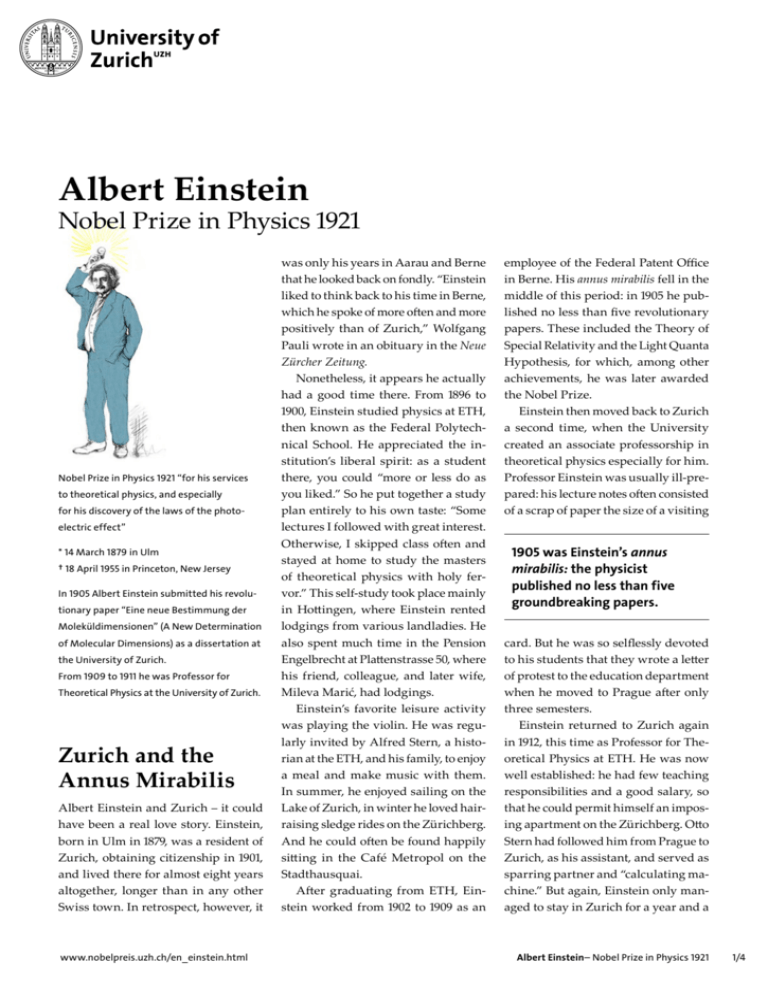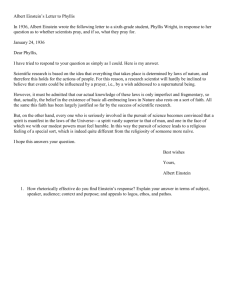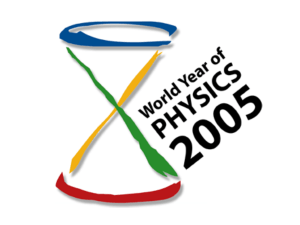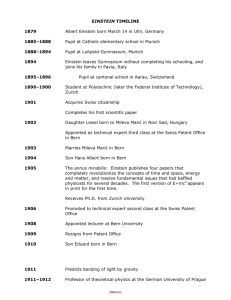Read more about Albert Einstein's life and work
advertisement

Albert Einstein Nobel Prize in Physics 1921 Nobel Prize in Physics 1921 “for his services to theoretical physics, and especially for his discovery of the laws of the photoelectric effect” * 14 March 1879 in Ulm † 18 April 1955 in Princeton, New Jersey In 1905 Albert Einstein submitted his revolutionary paper “Eine neue Bestimmung der Moleküldimensionen” (A New ­Determination of Molecular Dimensions) as a dissertation at the University of Zurich. From 1909 to 1911 he was Professor for Theoretical Physics at the University of Zurich. Zurich and the Annus Mirabilis Albert Einstein and Zurich – it could have been a real love story. Einstein, born in Ulm in 1879, was a resident of Zurich, obtaining citizenship in 1901, and lived there for almost eight years altogether, longer than in any other Swiss town. In retrospect, however, it www.nobelpreis.uzh.ch/en_einstein.html was only his years in Aarau and Berne that he looked back on fondly. “­ Einstein liked to think back to his time in Berne, which he spoke of more often and more positively than of Zurich,” Wolfgang Pauli wrote in an obituary in the Neue Zürcher Zeitung. Nonetheless, it appears he actually had a good time there. From 1896 to 1900, Einstein studied physics at ETH, then known as the Federal Polytechnical School. He appreciated the institution’s liberal spirit: as a student there, you could “more or less do as you liked.” So he put together a study plan entirely to his own taste: “Some lectures I followed with great interest. Otherwise, I skipped class often and stayed at home to study the masters of theoretical physics with holy fervor.” This self-study took place mainly in Hottingen, where Einstein rented lodgings from various landladies. He also spent much time in the Pension Engelbrecht at Plattenstrasse 50, where his friend, colleague, and later wife, Mileva Marić, had lodgings. Einstein’s favorite leisure activity was playing the violin. He was regularly invited by Alfred Stern, a historian at the ETH, and his family, to enjoy a meal and make music with them. In summer, he enjoyed sailing on the Lake of Zurich, in winter he loved hairraising sledge rides on the ­Zürichberg. And he could often be found happily sitting in the Café Metropol on the Stadthausquai. After graduating from ETH, Einstein worked from 1902 to 1909 as an employee of the Federal Patent Office in Berne. His annus mirabilis fell in the middle of this period: in 1905 he published no less than five revolutionary papers. These included the Theory of Special Relativity and the Light Quanta Hypothesis, for which, among other achievements, he was later awarded the Nobel Prize. Einstein then moved back to Zurich a second time, when the University created an associate professorship in theoretical physics especially for him. Professor Einstein was usually ill-prepared: his lecture notes often consisted of a scrap of paper the size of a visiting 1905 was Einstein’s annus mirabilis: the physicist published no less than five groundbreaking papers. card. But he was so selflessly devoted to his students that they wrote a letter of protest to the education department when he moved to Prague after only three semesters. Einstein returned to Zurich again in 1912, this time as Professor for Theoretical Physics at ETH. He was now well established: he had few teaching responsibilities and a good salary, so that he could permit himself an imposing apartment on the Zürichberg. Otto Stern had followed him from Prague to Zurich, as his assistant, and served as sparring partner and “calculating machine.” But again, Einstein only managed to stay in Zurich for a year and a Albert Einstein– Nobel Prize in Physics 1921 1/4 half – in 1914 he left for good, for Berlin. Einstein’s time in Zurich was thus fragmented, and also contained its fair share of disappointments. Already in 1895, as a 16-year-old, he failed the ETH’s entrance exam. He found it “quite right” that he did not get in: there were gaps in his knowledge, and he had to take the school-leaving certificate at the Aarau Cantonal School before he could begin his studies. He found it not so right, however, that after graduating as the only successful student of his year from ETH, he failed to receive an assistant’s position there. There were, however, reasons for that too: His final grade was only average, and his tendency to skip classes had not exactly endeared him to his professors. In 1899, he had even received just a 1 (the lowest grade) in his physics practical, on account of “lack of diligence,” accompanied by a reprimand from the director. Later, when he was a lecturer at the Physics Institute of the University of Zurich, there was friction with colleagues. Furthermore, before he had taken up his duties, the faculty committee had sent a letter containing anti-Semitic clichés to the cantonal education director – which, luckily, Einstein did not get to hear of. Ultimately, the main reasons for his rapid departure for Prague were poor remuneration and the prospect of a full professorship. There were also problems with his later appointment at the ETH. Robert Gnehm, president of the college council, long opposed the selection of Einstein, who was by now fairly famous, on the grounds that the position “was not suitable for Mr. Einstein,” as he was “not an outstanding lecturer.” The delay irritated Einstein, stuck unhappily www.nobelpreis.uzh.ch/en_einstein.html in Prague: “The good people of Zurich can get lost … apart from yourself,” he wrote to Heinrich Zangger, a forensic pathologist at the University, who had lobbied for his appointment. And he advised his friend not to make any further efforts: “You can confidently leave the ETH to God’s inscrutable wisdom.” Despite everything, Einstein retained a positive impression of Zurich at least until his middle years. He described the city as “my real home,” and, in Berlin during the war, he even referred to “my dear Zurich, my home Einstein’s lecture notes often consisted of a scrap of paper the size of a visiting card. town, which means more to me, as a convinced democrat, than ever in these times.” That the relationship subsequently cooled was above all to do with his family. Einstein’s rapid departure for Berlin was already influenced by the fact that he had fallen in love with his cousin, Elsa Löwenthal, who lived there. This did not exactly make the time in Berlin agreeable for Mileva, his wife, and after a short while she returned, with the two boys, Hans Albert and Eduard, to Zurich. Relations between Berlin and Zurich now deteriorated rapidly. The marriage ended in divorce in 1919 and Einstein married his cousin. He now hardly ever visited Zurich, not only on account of wartime travel restrictions, but also because of his negative feelings toward Mileva. Einstein even turned down a generous offer of a double professorship at the University and the ETH. After the tensions of the divorce had been to some extent overcome, the relationship with his exwife became more relaxed. Every year, Einstein spent some weeks of holidays with his sons, and he also came regularly to Zurich, where he lived with the family. But after emigrating to the USA in 1933, he did not return to Europe. Mileva, though, remained in Zurich. She was able to purchase her house at Huttenstrasse 62 and two rental properties at Hinterbergstrasse 86 und 88 with part of the Nobel Prize money, which Einstein had promised her in 1918 in order to persuade her to divorce: He had already been speculating on the prospect of the prize. When Einstein was in fact awarded the prize in 1922 – it applied retroactively for 1921 – the official announcement by the Noble Committee stated that it was awarded for his discovery of the photoelectric effect, but also generally for Einstein’s “services to theoretical physics,” which undoubtedly include the Theory of General Relativity, still today regarded by experts as the most beautiful of all theories in physics. Although Einstein completed it in Berlin in 1915, he worked particularly hard on it during his time at ETH, as evidenced by the “Zurich Notebook.” This shows that Einstein first wrote down the (almost) correct formulae for the field equations as early as 1912. But he then rejected them. Only three years later did he realize that he had been on the right track. So, Zurich is entitled to its own modest share in the prize. And two ETH graduates, Michele Besso and Marcel Grossmann also had a personal share in Einstein’s success. Grossmann’s mathematical abilities were indispensable to Einstein in the development of the Theory of General Relativity, while Besso worked mainly Albert Einstein– Nobel Prize in Physics 1921 2/4 on the Theory of Special Relativity. Einstein’s years in Switzerland are well documented. This is above all thanks to the Zurich literary figure Carl Seelig, whose papers are now in the library at the ETH. He contacted Einstein in 1952, when he was living in Princeton, interviewed many eye-witnesses, and wrote one of the first reliable biographies of Einstein. Touchingly, Seelig, who was the poet Robert Walser’s guardian, also began Experts today still regard the Theory of General Relativity as the most beautiful of all theories in physics. to concern himself with Eduard Einstein, who had been diagnosed with schizophrenia in 1933. While Einstein’s efforts in Zurich have always been regarded – by his contemporaries and by posterity – as significant, Mileva’s fate has attracted attention only in recent years. That she made a substantial contribution to Einstein’s work in physics, as has been asserted, is now generally regarded as disproved. She died in 1948 in the Eos private clinic at Carmenstrasse 18. Bad health and the poor economic situation had deprived her of her properties. Today, plaques on her house in the Huttenstrasse, at the place she died, and at the Nordheim cemetery commemorate Mileva Einstein-Marić. Mathias Plüss and Margrit Wyder Source: Margrit Wyder: Einstein und Co. – Nobelpreisträger in Zürich; Verlag NZZ libro, Zürich 2015 Illustration: Aline Telek Translation: University of Zurich Created in Zurich: the subject, in the Vierteljahrsschrift der The Theory of General Relativity Naturforschenden Gesellschaft in Zürich in The papers Einstein published in Berne in ory of General Relativity that a body would 1905 included the topic that was particu- deflect light through its gravitational field larly singled out by the Nobel Prize commit- was confirmed experimentally by English tee: In the photoelectric effect, irradiation astrophysicists during the eclipse of the sun with short-wave light causes a metallic on 29 May 1919. Their observations caused surface to emit electrons. The electrical a sensation in the media and made Einstein charge released during this process can world-famous. 1913, for instance. The theoretical prediction in the The- be measured. Though this effect had long Einstein’s theory and its consequences been known in physics, Einstein was the remain today subjects of scientific discus- first to explain it correctly, by developing sion and analysis, for they concern nothing the revolutionary Light Quanta Hypothesis. less than the structure, the past and the Only some twenty years later was the hy- future of the universe, and have resulted pothesis confirmed experimentally. in new concepts of space and time. And Already in the 1920s, however, Einstein an everyday piece of equipment like a GPS was famous in public perception as the cre- receiver is also influenced by it. The navi- ator of the Theory of Relativity. According gation system is based on 24 satellites that to the Theory of Special Relativity, which broadcast their position and the exact time was also published in 1905, there can be no continually, using radio signals. On account higher speed than the speed of light (c), at of the reduced gravitation at the height of around 300,000 kilometers per second. It 20,000 kilometers, clocks go faster than is independent of the uniform motion of they do on earth. On the other hand, the an observer. As a natural constant, it forms high speed of the satellites means that they part of the most famous equation in phys- go slower compared to an earth-based re- ics: E = mc . With this equation, Einstein ceiver. If both these relativity effects were was able to link together the concepts of not corrected, within a few days there mass (m) and energy (E). would be a discrepancy in position-finding 2 The Theory of General Relativity is an of several kilometers. (MW) expansion of the Theory of Special Relativity. Einstein incorporated gravity into it, and thus took account of accelerated motion as well as uniform motion. Galileo Galilei’s experiments had already shown that all bodies, such as an iron ball and a feather, fall equally fast in a vacuum. Gravity thus affects them regardless of form or mass. Einstein worked intensively on the theory in Zurich. His friend and colleague, Marcel Grossmann, Professor for Descriptive Geometry at the ETH, helped him set up the complex equations. Between 1908 and 1915, Einstein published several papers on www.nobelpreis.uzh.ch/en_einstein.html Albert Einstein– Nobel Prize in Physics 1921 3/4 Albert Einstein as a student. Photo: ETH Library, archives From 1909 to 1911, Albert Einstein researched and taught at the University of Zurich’s former physics building at Rämistrasse 69. Mileva Einstein with sons Eduard (left) and Hans Albert, 1914. Photo: Albert Einstein Archive of the Hebrew University of Jerusalem www.nobelpreis.uzh.ch/en_einstein.html In 1905, 26-year-old Albert Einstein submitted his dissertation “Eine neue Bestimmung der Moleküldimensionen” (A New Determination of Molecular Dimensions) at the University of Zurich. Albert Einstein– Nobel Prize in Physics 1921 4/4






